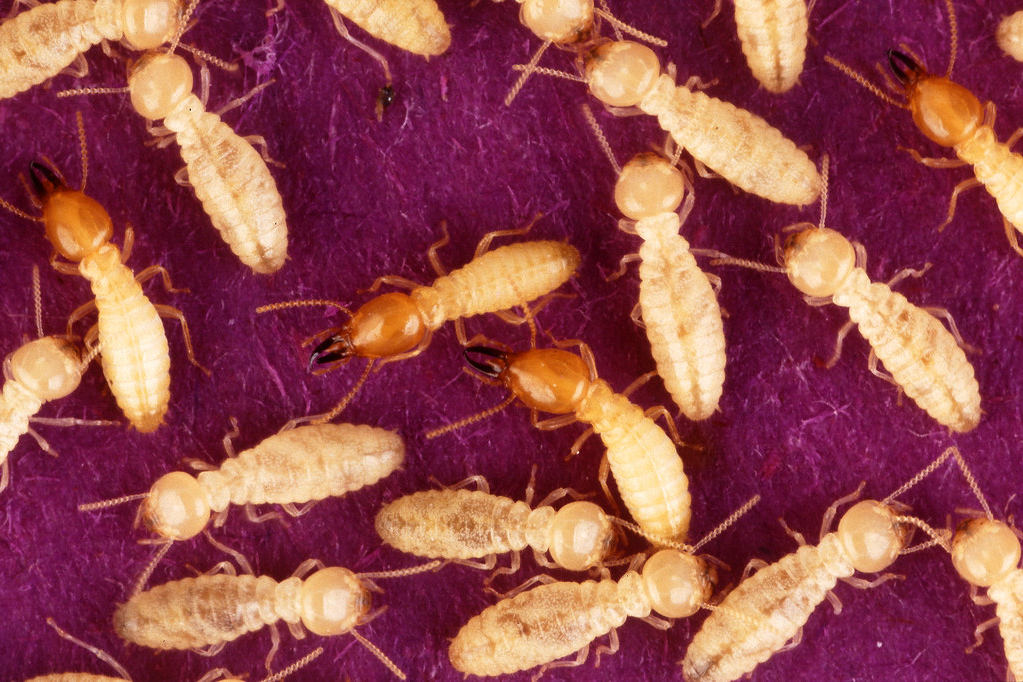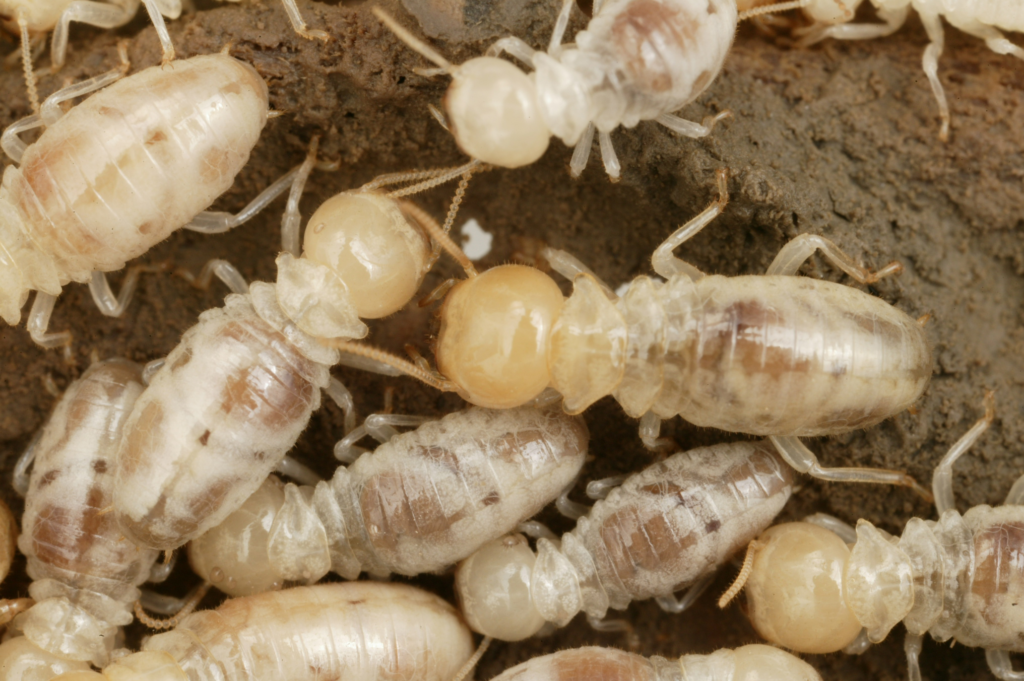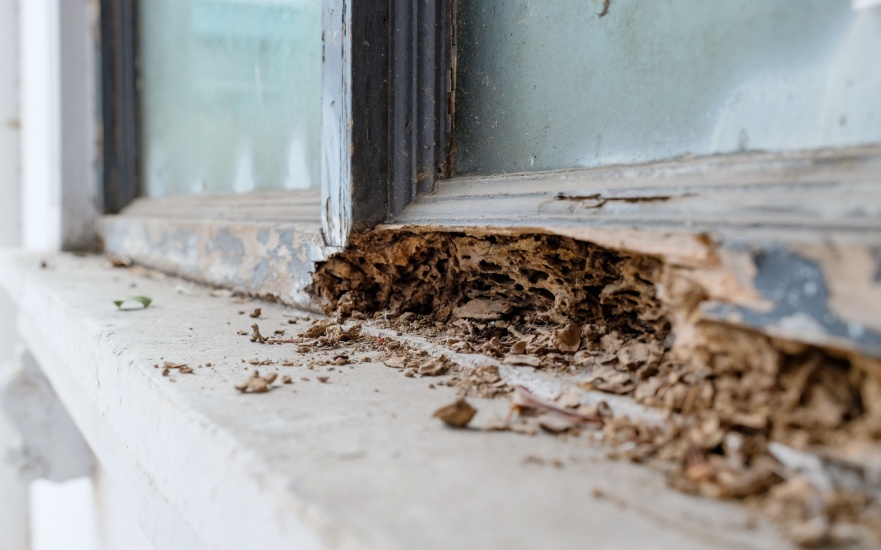Termites can live on your property or inside your home for a long time before you notice them. Finding a termite infestation early is key to avoid expensive damage to your home.
These pests can harm your property a lot, but you might not see it until it’s too late. The signs of termite activity can be small, but knowing them can help you spot a problem.
Key Takeaways
- Early detection is key to avoid expensive termite damage.
- Termite infestations can hide for a long time, so regular checks are important.
- Signs of termite activity include mud tubes, discarded wings, and damaged wood.
- Regular inspections can help find termite problems early.
- Being proactive can save you from expensive repairs later.
Understanding Termites and Their Behavior
Knowing about termites is key for homeowners to keep their homes safe. Termites live in groups and eat wood and other cellulose materials.
What Are Termites?
Termites are small, social bugs that live in groups. They like warm, wet places and eat wood and cellulose. There are many types of termites, but they all harm wood and cellulose.

Why Termites Are Attracted to Homes
Termites like homes because of the food and wet places. They are drawn to homes because of:
- Moisture: Termites need water to live, and homes with leaks or damp air are perfect.
- Wood and Cellulose: Homes have wood and cellulose, which termites love to eat.
- Soil: Subterranean termites live in soil and like homes with soil near wood.
Common Types of Termites in the United States
In the United States, there are many termites, but subterranean and drywood are the worst. Knowing about these types helps homeowners fight termite problems better.
| Type of Termite | Habitat | Behavior |
|---|---|---|
| Subterranean Termites | Live in soil, build mud tubes to reach food | Highly social, large colonies |
| Drywood Termites | Live within the wood they infest | Smaller colonies, can infest dry wood |
By learning about these termites, homeowners can stop them before they start. This keeps their homes safe.
Visual Signs of Termite Infestation
Spotting termite damage early is key. Termites leave signs that homeowners can see. These signs help fight termite problems.
Mud Tubes on Exterior Walls
Termites make mud tubes to get to food. These tubes show up on walls. They are a clear sign of termites.
- Mud tubes are brown or tan.
- Look for them on walls, near windows, and doors.
- Check these spots often for mud tubes.
Discarded Wings Near Windows and Doors
When termites swarm, they lose their wings. These wings show up near windows and doors. They are a sign of termites.
Learn more about termite swarms and how to spot them. Visit our page on the top signs of termite problems.

Visible Wood Damage
Termites eat wood, causing damage. Look for:
- Hollowed or damaged wood.
- Wood that looks darker or discolored.
- Termite droppings or frass.
Bubbling or Uneven Paint
Termite activity can make paint bubble or look uneven. This is because of moisture from termites.
Regular checks can catch these problems early. This allows for quick action.
Auditory and Physical Signs of Termites
Termites can cause sounds and changes in your home. Knowing these signs can help you find termites early. This can save you from expensive fixes.
Hollow-Sounding Wood
Wood that sounds hollow is a sign of termites. They eat wood from the inside, leaving a thin layer outside. When you tap it, it sounds different because the inside is hollow.
Clicking Sounds Within Walls
Termites make clicking sounds in walls. Soldier termites hit their heads to make these sounds. These clicks might be hard to hear, but listening for them can help find termites.

Tight-Fitting Doors and Windows
Termites can also make doors and windows hard to open. They eat wood, causing frames to warp. If doors or windows are harder to move, termites might be there.
To find termites and fix any problems, talk to experts. They can do termite inspections in Dallas, TX. Finding termites early helps fix damage and treat them well.
Termite Swarms: A Major Warning Sign
Seeing a termite swarm near your home can be scary. But it’s a big sign that termites might be there. It means you should act fast.
Understanding Termite Swarms
A termite swarm happens when many termites leave their home to start new ones. This is when their old home is too full.
Swarming termites look different from other bugs. Knowing how to spot them is important. It helps you catch termites early.
Timing of Termite Swarms
Termites swarm at certain times, based on where they live and what kind they are. In the U.S., subterranean termites swarm in spring or early summer. They do this on warm, sunny days after it rains.
- Spring swarms are common in many places, because of the warmer weather.
- Some termites swarm in the fall, in warmer areas.
- They can swarm inside or outside, often near lights.
Differentiating Termites from Flying Ants
Many people get confused between termite swarms and flying ants. But they are different:
- Termites have straight antennae, flying ants have bent ones.
- Termites have a wide waist, flying ants have a thin one.
- Termite wings are the same size and longer than their body.
Knowing these differences is key to spotting termites. If you’re not sure, call a pest control expert. Like those at Vinx Pest Control, they can help you figure it out.
The Destructive Impact of Termite Damage
Termite infestations can cause big problems for homeowners. They can damage the structure of a home and cost a lot of money. It’s important for homeowners to know how bad termites can be and act fast.
Structural Compromise
Termites eat wood, which can harm a home’s structure. This can cause:
- Sagging floors and ceilings
- Cracked walls and foundations
- Doors and windows that stick or become difficult to open
These signs mean termites are damaging your home. This could lead to expensive fixes.
Damage to Personal Property
Termites don’t just harm a home’s structure. They can also damage personal items. For example:
- Termite-damaged flooring may need to be replaced entirely
- Furniture infested with termites can be beyond repair
- Important documents stored in wooden containers can be destroyed
Financial Implications
The cost of termite damage can be very high. Fixing structural damage and replacing items can cost a lot. Also, termite damage can lower a home’s value, making it hard to sell.
It’s important to catch termite problems early. Homeowners should watch for signs of termites and get help right away.
DIY Termite Inspection Techniques
Knowing what to look for is the first step in fighting termites. A DIY termite check is very helpful. You can do a basic check with the right tools and by focusing on certain spots around your house.
Tools Needed for Basic Inspection
To find termites, you need some basic tools. You’ll need a flashlight, a screwdriver, a ladder, and a magnifying glass. These tools help you check your home inside and out well.
- Flashlight for illuminating dark areas
- Screwdriver or probing tool for checking wood integrity
- Ladder for accessing high areas
- Magnifying glass for examining details closely

Areas to Focus Your Inspection
When you do a DIY termite check, focus on certain areas. Start with your home’s outside. Look for mud tubes, damaged wood, and other termite signs. Then, check inside, around windows, doors, and other spots termites might get in.
- Exterior walls and foundation for mud tubes
- Windows and doors for signs of termite activity
- Attics and crawl spaces for termite damage
Regional Termite Hotspots in the United States
Termite problems differ by area. Knowing the local termites and their habits helps your check. For example, the southeast has a lot of subterranean termites.
Documentation for Insurance Purposes
It’s important to document your termite findings, mainly for insurance claims. Take photos of any damage or termite signs. Keep a record of your checks. This can help a lot with your insurance claim.
By using these DIY termite check tips, homeowners can fight termites early. This can save a lot of money on repairs. Regular checks and knowing about termite behavior and hotspots are key to stopping termites.
Professional Termite Control Solutions
Professional termite control uses many ways to get rid of termites. When termites attack a home, it’s important to act fast. Vinx Pest Control has solutions for homeowners in the United States.
Liquid Termite Barriers
Liquid termite barriers are a common choice. They make a barrier around the home to keep termites out. The liquid goes into the soil around the foundation, protecting the home.
Termite Baiting Systems
Termite baiting systems are also effective. They use bait stations around the home. The bait kills the termites, including the queen, over time.
Wood Treatments and Fumigation
For big termite problems, wood treatments and fumigation might be needed. Wood treatments kill termites in the wood. Fumigation uses gas to kill termites, but you have to leave the home.
Vinx Pest Control’s Termite Management Approach
Vinx Pest Control has a detailed plan for termite control. They use different methods to protect your home. For more info on keeping your Dallas, TX home safe from termites, visit https://vinxpestcontrol.com/protect-your-dallas-tx-property-from-termites/.
Preventing Future Termite Problems
To keep your home safe from termites, you need a good plan. Know what termites like and act early. This way, you can lower the chance of termites showing up.
Moisture Reduction Around Your Home
Termites love moisture. So, it’s key to keep your home dry. Make sure your home’s water system works right. Fix leaks fast.
Check your home’s base and walls for water damage often.
- Fix leaky faucets and pipes.
- Ensure proper grading around your home to direct water away from the foundation.
- Use a dehumidifier in humid areas like basements or crawl spaces.
Eliminating Wood-to-Soil Contact
Termites can get into your home if wood touches soil. Keep wood off the ground. This stops termites from getting in.
- Use concrete or metal supports for decks and porches.
- Keep firewood and other wood piles away from your home and off the ground.
- Remove dead trees and stumps.
Regular Maintenance and Inspections
Checking your home often is key. Get a pro to check for termites every year. This catches problems early.
- Inspect for signs of termite activity, such as mud tubes or discarded wings.
- Check for damaged or rotting wood.
- Maintain a record of your inspections for future reference.
Landscaping Considerations
Your yard choices can help or hurt against termites. Pick plants that keep termites away. This makes your yard less inviting to them.
- Avoid planting trees or shrubs too close to your home.
- Keep your yard free of debris and clutter.
- Use termite-resistant materials for landscaping features.
Conclusion: Taking Action Against Termites
Knowing the signs of termite infestation is very important. It helps prevent big damage to homes. Homeowners can spot signs like mud tubes, hollow sounds, and small holes.
There are many ways to fight termites. You can get help from professional pest control or try DIY methods.
Spotting termites early is very important. It helps keep damage small. Homeowners should act fast when they see any signs.
By knowing how to spot termites and how to control them, homes can stay safe. Regular checks and upkeep are key. This keeps homes free from termites for a long time.
FAQ
Q: What are the common signs of a termite infestation?
A: Look for mud tubes on walls, wings near doors, and wood damage. Also, check for bubbling paint and hollow wood sounds. Tight doors and clicking sounds are other signs.
Q: How can I differentiate termites from flying ants?
A: Termites have straight antennae and a broad waist. Their wings are the same size. Flying ants have bent antennae and a narrow waist. Their wings are different sizes.
Q: What is a termite swarm, and what does it indicate?
A: A termite swarm is when termites leave to mate. It happens in spring and summer. It means there’s a big termite colony nearby.
Q: How can I prevent termite infestations?
A: Keep your home dry and don’t let wood touch the ground. Check your home often. Keep trees and shrubs away from your home too.
Q: What are the most effective termite control solutions?
A: Good solutions include liquid barriers and baiting systems. Wood treatments and fumigation also work. Vinx Pest Control offers a full plan to keep termites away.
Q: How often should I inspect my home for termites?
A: Check your home for termites at least once a year. If you live in a termite area, check more often. Early detection is key.
Q: What are the financial consequences of termite infestations?
A: Termites can cause a lot of damage and cost a lot to fix. Catching them early can save money.
Q: Can I perform a termite inspection myself?
A: Yes, you can check for termites yourself. But, a pro like Vinx Pest Control can do a better job.
Q: What are regional termite hotspots in the United States?
A: Hotspots are places with warm, humid weather. The Southeast and Southwest are examples. Knowing your area’s risk helps prevent termites.
Q: How can I document termite damage for insurance purposes?
A: Take photos and keep records of inspections and repairs. Save receipts for repairs. This helps with insurance claims.



